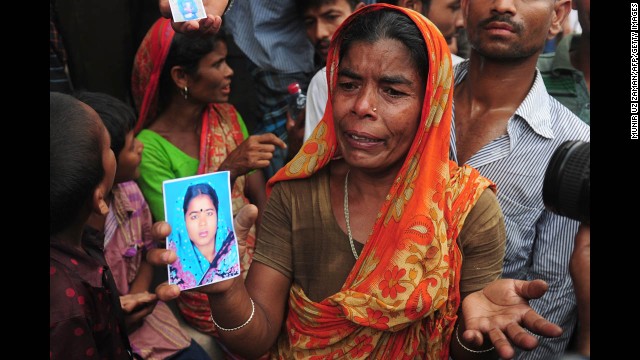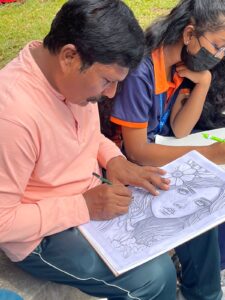RESCUERS SCOUR MANGLED HEAP AFTER BANGLADESH BUILDING COLLAPSE KILLS 204

A Bangladeshi woman shows a portrait of her missing daughter in-law, believed trapped in the rubble following the collapse of an an eight-storey

DHAKA, BANGLADESH( MT NEWS) — More than a day after a Bangladesh building collapsed, killing hundreds of people, rescuers searched Thursday for survivors as thousands took to the streets to protest lax safety conditions.
“So far, 204 bodies were retrieved and 2,013 people were rescued alive from under the debris,” Maj. Gen. Abul Hassan Sarwardy, who is overseeing the effort, told reporters, according to the national news agency Bangladesh Sangbad Sangstha.
The eight-story building on the outskirts of the capital, Dhaka, fell Wednesday morning, entombing its contents in a pile of broken concrete and twisted metal.
Witnesses said food and bottles of water were being dropped to areas where people were trapped.
The building housed five garment factories employing about 2,500 workers, a bank and some 300 shops, the news agency said.
After cracks appeared in the building Tuesday, many of the workers had expressed concern about its safety, survivors told CNN.
But factory owners told them the building was safe and ordered them to report for work, the survivors said.
“The fact is we don’t know yet how many people were killed actually … but I can tell you the building was not built in compliance with the (safety) rules and regulations,” Home Minister Mahiuddin Khan Alamgir told reporters Wednesday.
The nation’s high court ordered the owners of the building and of the factories to appear in court on April 30, CNN affiliate Boishakhi Television said.
Thousands of people protested the collapse in the streets of Dhaka on Thursday. Many carried black flags; some set fires, and others used clubs to break the windshields of passing trucks.
The incident is the latest to strike Bangladesh’s garment industry, which employs more than 4 million people — most of them women — and regularly comes under scrutiny for its slipshod safety standards.
It also raises questions for the Western brands that contract with factories here to make their products.
Ninety percent of the country’s buildings are not built according to code, Prime Minister Sheikh Hasina said. “For this, shall we have to demolish all the buildings right now?” she asked. “Why was there no awareness before building such constructions?”
A rush to help, then mourning
Rescue crews carried off the injured and dead on stretchers Wednesday. Some of them used brightly colored material from the garment factories to cart off the victims.
Some onlookers wept while others dug with their bare hands. “After learning that the building collapsed, I rushed here looking for my wife, but until now I haven’t found her,” said Siraj Miah.
Abdul Alim, a day laborer, said he heard screams from inside the building.
“We couldn’t make our way to get in,” said Alim, one of thousands of onlookers who tried to reach trapped victims before military, fire and civil defense rescuers arrived.
Flags nationwide were flying at half-staff Thursday after the government declared a national day of mourning.
Workers told to enter
Authorities say they have not determined the cause of the collapse.
Workers from the garment factories said that after the cracks were discovered Tuesday, managers initially ordered them not to report to work the next day.
But factory owners reversed the order, telling employees that the building was safe, said Marjina Begum, who worked on the sixth floor.
Many workers reported to work Wednesday because they were afraid of losing their jobs, she said. More than a dozen other workers corroborated her story.
Managers for the garment manufacturers housed inside the building could not be reached for comment.
M. Atiqul Islam, president of the garment manufacturers association, said owners kept the factories open only after the building’s owner told them the cracks did not indicate a threat to the structure of the building.
The national news agency reported that the owners of the factories and the building housing them had gone into hiding. They are facing cases from regulators and police over the construction of the building and the exposure of the workers to risk, the agency said.
Employees of a bank branch were removed from the building Tuesday after the crack was detected and were ordered not to show up Wednesday, according to a statement from the bank cited by the news agency. None of the bank’s workers were among the injured or dead, it said.
In addition, a strike had shut a mall housing hundreds of shops on the building’s two lowest floors.
Links to retailers
Garment contractors here appeal to merchants because of workers’ low wages.
It was not immediately clear which retailers were doing business with the factories.
Previous disasters
The last major building collapse in the country occurred in 2005 in the same area and killed more than 70 people, the national news agency said.
A fire at the Tazreen Fashions Factory in another suburb of Dhaka in November killed at least 112 people. Tazreen had made goods for Walmart and Sears, though both companies said they were unaware that the factory had made goods for them.
Garments account for 80% of Bangladesh’s $24 billion in exports.
The country has about 4,500 garment factories where workers make clothes for various international brands. It’s on track to surpass China within seven years as the world’s largest apparel manufacturer.
Scott Nova, executive director of the Worker Rights Consortium, said the pressure to cut prices results in substandard safety conditions.
“The worse the dangers get, the more business comes in, so the government has no incentive to fix anything,” he said. “We ask ourselves every day what it’s going to take to fix this.”
CNN’s Tom Watkins reported and wrote from Atlanta, Journalist Farid Ahmed reported from Dhaka. CNN’s Jethro Mullen, Elizabeth Joseph, Samira Said, Sumnima Udas and CNNMoney’s Emily Jane Fox contributed to this report.




